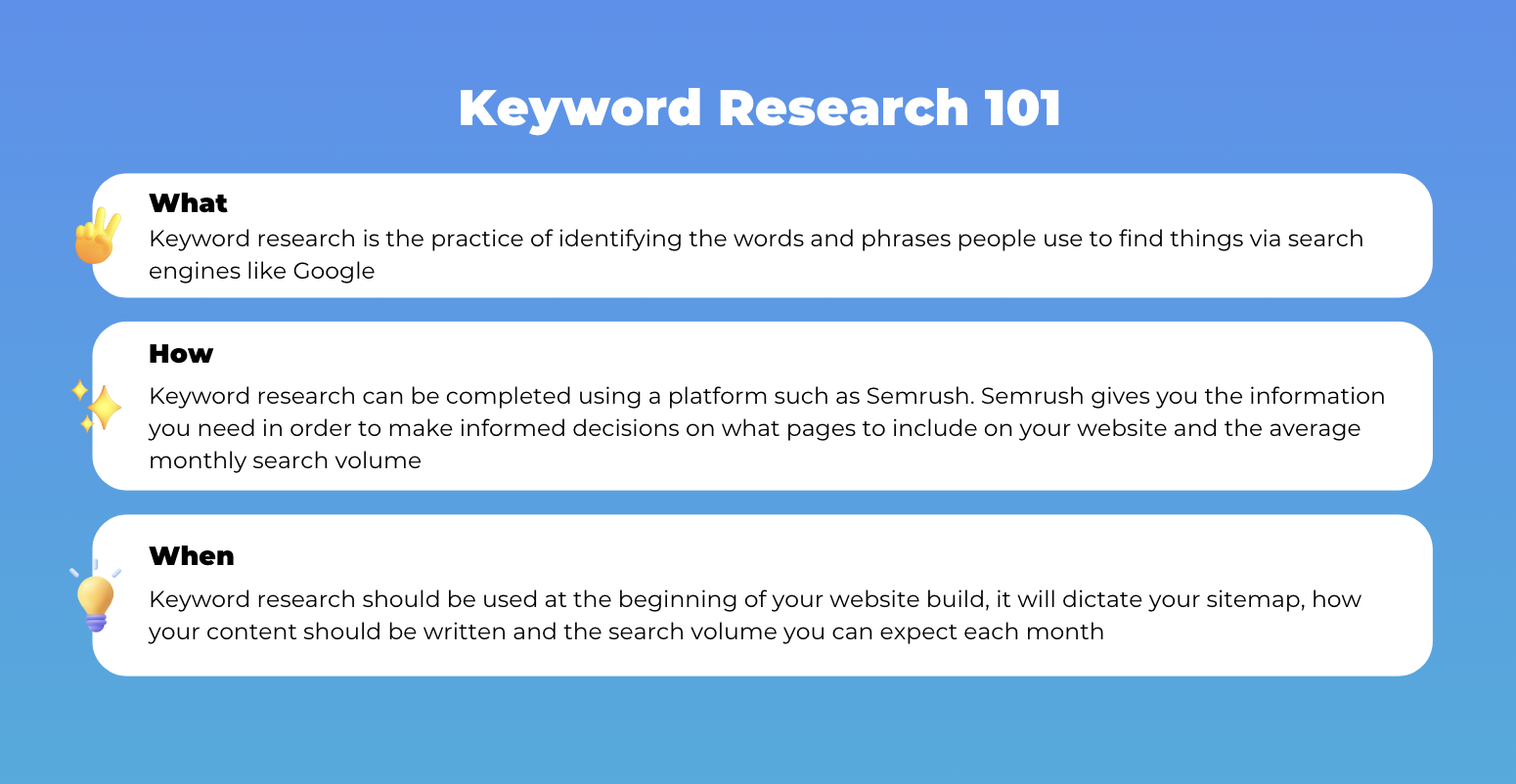Keyword research is essential for SEO success and how to conduct keyword research is the first step. It involves identifying what your audience searches for online (yes, we are stalking their online habits!). Good keyword research increases your website’s visibility and traffic, which in turn, will lead to more leads and enquiries coming through the door. Understanding and using this technique is crucial for better Google rankings.
In our webinar, Matt, one of our Senior SEO Strategists, walks you through the basics of keyword research, how to find keywords for your business and how to implement this on your website!
At Five by Five, we build great-looking, high-performing websites, and are known as one of the Gold Coast & Australia’s leading WordPress web design & SEO agencies. We have nearly two decades of experience in the web design industry. If you or your business need a new, high-performing digital solution, then contact us today and find out why we have 200+ 5* Google reviews.
Check out a snippet below!
SEO stats you need to know in 2024
How to implement keyword research
What is keyword research?
Keyword research uncovers the words and phrases people use in search engines. It’s the foundation of SEO, guiding content creation and strategy. This research helps in predicting shifts in demand (like looking into a crystal ball), responding to market conditions, and producing content that searchers are actively seeking.

Types of Keywords
- Transactional Keywords: Used when intent to purchase is high.
- Navigational Keywords: For finding a specific brand or website.
- Commercial Keywords: When users are researching before buying.
- Informational Keywords: For general information or answers to questions.
Effective keyword research shapes your website’s structure. It influences everything from your sitemap to blog posts, ensuring your content aligns with what your audience is searching for. By understanding and implementing these keyword types, you can create a website that not only attracts more visitors but also caters to their specific needs and intents.
A step-by-step guide on how to conduct keyword research
Begin by brainstorming the topics relevant to your business. Think about the questions your customers ask and the problems they’re trying to solve. Use these ideas as a starting point for identifying potential keywords. A great place to start is to look at your key service areas and the type of keywords people are searching for when looking for your service.
Tools for Effective Research
Several tools can streamline your keyword research:
- SEMrush: Offers extensive features for keyword analysis.
- Google Search Console: Provides insights into how your site performs in Google searches.
- Backlinko: A resource for learning advanced SEO strategies with a free keyword research tool.
- Ubersuggest: Another free tool that generates keyword ideas.
Look for keywords with a good balance of search volume and competition. High-volume keywords might be too competitive, while low-volume ones might not drive enough traffic. Aim for those that are relevant and have a reasonable chance of ranking well in search results.
Primary and Secondary Keywords
Your primary keyword should be the main focus of your page, it will be in the heading and content but we will dive into that more below. Secondary keywords are related but less central. They support the primary keyword and help to attract a broader audience.
This approach to keyword research lays the groundwork for a robust SEO strategy. It allows you to understand your audience better and create content that resonates with their search behaviours.
Advanced keyword research techniques

It is essential to focus on specific strategies that can significantly enhance your SEO efforts. There are many strategies when it comes to conducting keyword research, however, a few of our favourites are below.
Combining long-tail keywords and local SEO
Long-tail keywords (three to five words), being longer and more specific, usually face less competition and lead to higher conversion rates. Incorporating location-based keywords for local SEO, like “commercial electrician Melbourne,” targets local clientele effectively.
Understanding search intent
Recognising the intent behind keywords is crucial for aligning content appropriately. Whether users are looking to buy, seeking information, or browsing, match your content to these needs. Tools like SEMrush are helpful in analysing content types that rank for your chosen keywords, shedding light on user expectations. As an example, someone searching using the terms ‘how to’ will be looking for informative, blog-like content while someone including ‘buy’, ‘subscribe’ etc… in their search is at the end of the buyer’s journey.
Mastering SEMrush's Keyword Magic Tool
The Keyword Magic Tool in SEMrush is a game-changer, offering deeper insights into your primary keywords. It helps find keyword variations, provides search volume data, and assesses competition levels. Additionally, it identifies gaps in your keyword strategy, suggesting new content opportunities to meet unmet user needs. This is a tool we use daily and we can’t recommend it enough!
Creating location-specific pages
When targeting specific locations, create dedicated pages for each area. Use identified local SEO keywords and ensure each page has unique content tailored to the local audience, avoiding generic information with swapped location names. At Five by Five, we use location-specific pages to target key areas for our services, such as Brisbane, Melbourne and Sydney.
These advanced techniques in keyword research involve understanding the finer details of audience search behaviour. By grasping the subtleties of search intent and using tools like SEMrush, you can craft a more targeted and effective SEO strategy. This approach not only improves your site’s visibility but also ensures your content is more relevant and high-quality for your audience.
How to integrate keyword research into your website
Creating a website that performs well in search engines begins with a keyword-optimised site structure. This approach ensures that your site is not just a collection of pages but a cohesive unit that aligns with user searches.

Balancing sitemap and keyword research
A well-thought-out site map is the starting point, this is where we always start our journey with a client! However, it should evolve in tandem with your keyword research. For instance, when building a site for a commercial electrician, integrating specific service pages and location-based keywords into the site map is key. This process involves a collaborative effort, intertwining site mapping with keyword strategy to maximise SEO effectiveness.
Influencing content strategy with keywords
Once your sitemap and keywords are aligned, the next step is crafting content, the most creative part! Each page should focus on a primary keyword, with supporting secondary keywords woven naturally into the content. This ensures that every page is optimised for both search engines and user experience.
Creating a user-friendly and SEO-optimised website
A keyword-optimised site structure goes beyond SEO, it enhances user experience. Users find what they’re looking for more easily, and search engines can better understand and rank your site. Remember, a website that is easy to navigate and informative will keep visitors engaged longer, reducing bounce rates and improving overall site performance.
Optimising URLs, meta titles, and descriptions
A crucial aspect of on-page SEO is crafting URLs, meta titles, and descriptions that incorporate your primary keywords. This not only aids in search engine ranking but also improves click-through rates from search results. Keep meta titles under 60 characters and meta descriptions around 150 characters for optimal display in search results.
Utilising H1 and H2 tags effectively
Your H1 tag should clearly include the primary keyword as it signifies the main topic of the page to search engines. For example, the H1 of this page is ‘How to conduct keyword research’ as that is our primary keyword. H2 tags are used for subsections and should incorporate secondary keywords. This hierarchical structuring helps search engines understand the content better and rank it accordingly.
Balancing keywords and readability
When writing content, balance is key. Integrate your chosen keywords naturally, ensuring the text remains engaging and readable. Gone are the days of keyword stuffing, people can spot this from a mile away. Today’s SEO demands content that is informative and easy to read while subtly including keywords.
Regular updates and keyword refreshment
SEO isn’t a one-time task. Regularly review and update your content to ensure it stays relevant and continues to perform well in search engines. As market trends and language evolve, so should your website content, keeping it fresh and in line with current search behaviours.
Monitoring and adapting your keyword research
Search trends and keyword effectiveness are not static, they evolve over time. Regular monitoring of your keyword strategy is essential to ensure continued SEO success. This adaptability is key to staying ahead of your competition and maintaining the top spot in Google!
Tools like Google Analytics and Search Console are invaluable for tracking the performance of your keywords. They provide insights into which keywords are driving traffic and which ones might need revision. Analyse user behaviour, bounce rates, and conversion metrics to gauge the effectiveness of your keyword strategy.
As new trends emerge and language evolves, updating your content with current keywords is crucial. This not only helps in maintaining rankings but also ensures your content remains relevant and engaging for your audience. Regular updates can also open new avenues for traffic and conversions.
Achieve your digital marketing goals with keyword research

Remember, keyword research is more than just finding the right words, it’s about connecting with your audience most effectively. By aligning your content with user intent and continuously adapting to search trends, you are guaranteed to create a website that resonates with your audience and stands out in search engine results.
The journey through SEO and keyword research is ongoing. It requires patience, adaptability, and a keen eye for detail. But with these strategies in hand, you’re well-equipped to elevate your website’s performance, drive more traffic, and achieve your digital marketing goals.
Embrace these insights and start applying them to your SEO strategy. With dedication and the right approach, you’ll see your website climb the ranks, attracting more visitors and converting them into loyal customers. The power of effective keyword research is immense – harness it to unlock your website’s full potential.
If you need some help in nailing this, feel free to reach out today to learn more about how our SEO team can help you snag the top spot in Google!
















